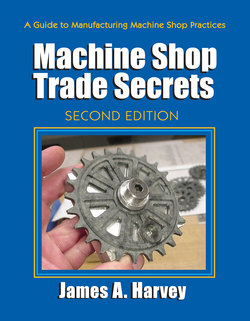Читать книгу Machine Shop Trade Secrets - James Harvey - Страница 9
ОглавлениеOne of my favorite quotes as it related to working in a machine shop was spoken by a veteran toolmaker I once worked for. It was in response to my complaining about having wasted time working on a part that was already out of tolerance. He said, “All I know is if I don’t check it…it’s wrong.”
It seems you can double check things all day long without finding an error. Then, the first time you don’t check something, that’s the measurement that’ll be wrong.
Part of learning any trade is learning how to avoid trouble. Mistakes are no fun. The trick is to try to develop habits and ways of working that reduce your chances of making mistakes without wasting time.
This chapter lists suggestions that may help you stay out of trouble. Everybody is different in how they approach jobs; each of us has our own strengths and weaknesses. With that in mind, some of the following suggestions should give you some insight into avoiding errors.
1.There is no such thing as a simple job.
I’ve seen so many simple jobs screwed up that I’ve come to the conclusion there is no such thing. So-called “simple” jobs get screwed up because people have a tendency to start cutting without planning or double checking anything. You have to train yourself to identify simple jobs and then be extra careful when working on them. Believe me—it’s easier said than done!
2.Measure raw stock before you begin machining.
I’ve seen a lot of grief caused as a result of people not measuring or double checking raw stock size. Before machining begins, and that includes saw cutting, you should always check raw stock size to make sure it is what you want. For example: You order 1/2" diameter bar stock from a vendor. The vendor delivers and you saw cut the bar to the appropriate lengths. Later someone realizes the vendor mistakenly delivered 7/16" diameter bar. Grief usually follows.
3.Lay out work for consistent results. (See Fig. 2-1)
This suggestion applies mainly to parts that are going to be machined conventionally. You won’t see many parts laid out for CNC machining simply because the layout, in essence, is done in the CAD (computer-aided design) system.
Some people think scribing layout lines on parts is a waste of time. In most cases with conventional machining, I believe it is time well spent. The layout lines drastically reduce bad cuts; they also make parts easier and faster to machine. After squaring material to size, I almost always lay out hole locations, pockets, and other features on the first part.
Laying out work is also a great way to check drawings for errors or omissions. If the drawing provides enough information to make the layout, you can usually make the part.
You can use calipers to make layout lines. When I first started machining, I was shy about using calipers. I’d look around to make sure nobody was watching and then quickly use them to scribe a line.
Figure 2–1 Dial calipers can be used to quickly scribe layout lines on parts. Layout lines in combination with digital readout numbers can drastically reduce bad cuts.
I’ve come to the conclusion that using calipers is one of the fastest and easiest ways to scribe lines. I don’t expect lines scribed with calipers to be too accurate. I use them mainly as a double check. You can mark areas for scribing beforehand with a black felt tip pen to make the layout lines stand out better. The ink from the pen is easily removed with rubbing alcohol.
If a part is complex and needs many lines, I may use a height gauge to make the layout. You can get a cleaner, more accurate layout with a height gauge than with calipers.
On lathe parts, you don’t have to scribe layout lines. Instead, you can use the cutting tool when the part is spinning to create a target mark to roughly cut to. That way, you won’t have to constantly watch dials and readouts.
The use of layout lines and visual targets makes machining easy.
4.Lightly spot the surface of a workpiece with a center drill before drilling holes.
Another way to double check hole locations is to first lightly spot the surface of the work with a center drill, then check the location of the spot with a scale. If you happen to be off for some reason, you’ll be able to correct the error before drilling in the wrong location and possibly ruining the work. This technique can also be used when drilling holes with a CNC mill.
5.Double check measurements and calculations.
